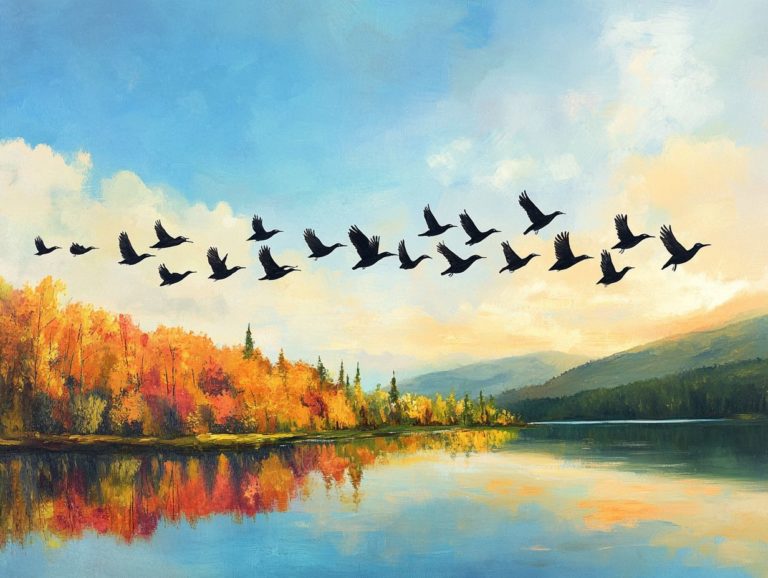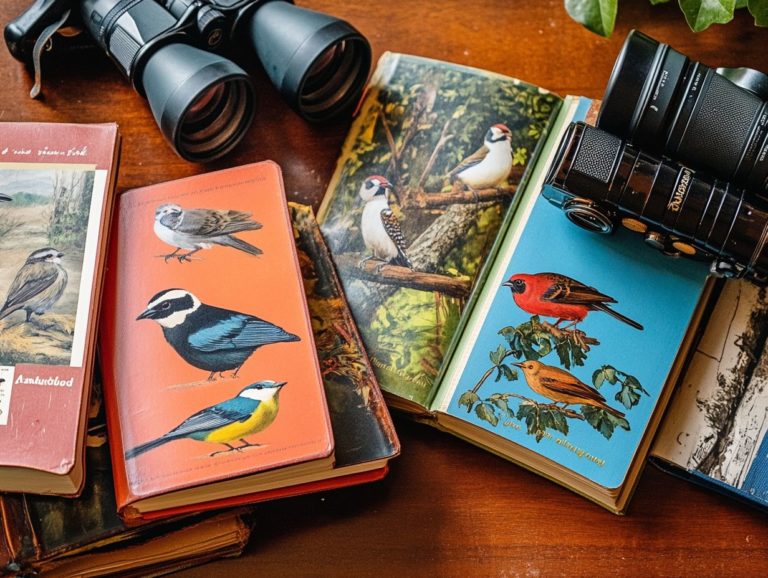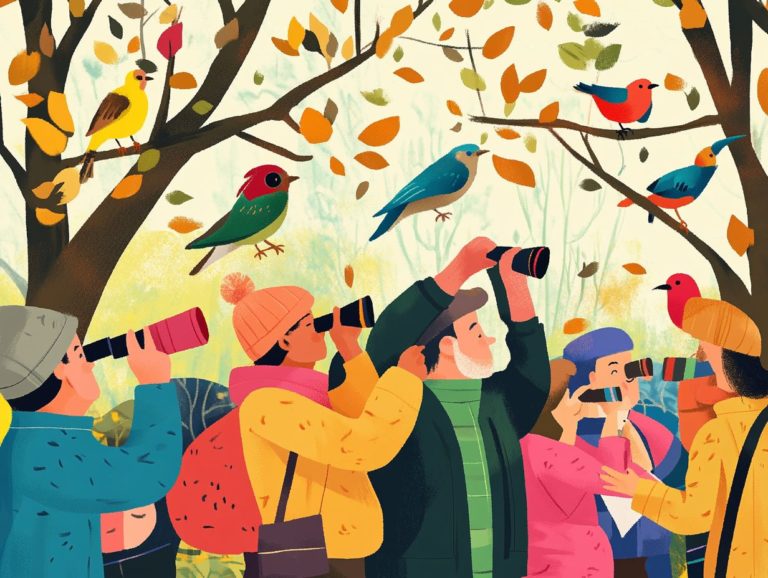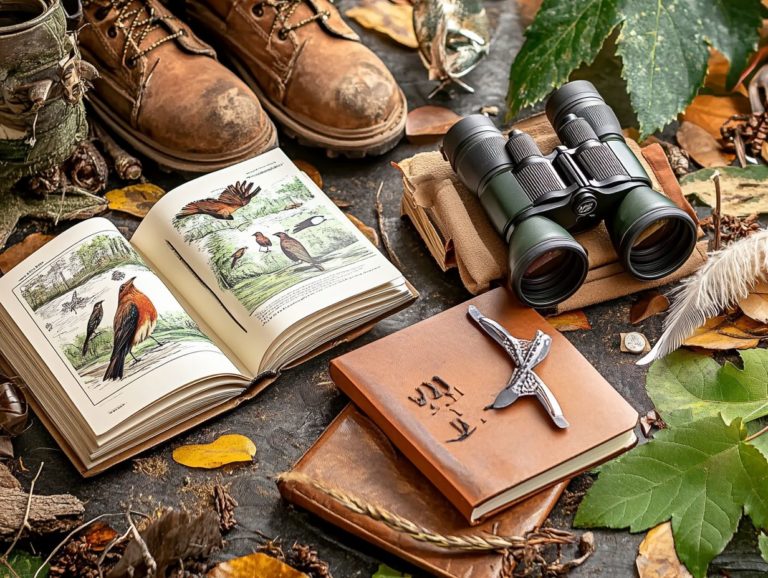7 Simple Ways to Make Bird Watching More Enjoyable
Bird watching is not only a leisurely hobby but also an enjoyable way to connect with nature and enhance your health in various ways. Whether you are a seasoned enthusiast or a beginner, there are simple strategies to enhance your birding experience, making it a fulfilling pandemic hobby.
This article offers tips on choosing the right setting, selecting the appropriate binoculars, and learning to identify birds by their calls. All these strategies aim to improve your birding adventures. It also explores the psychological and physical benefits of bird watching.
Get excited to discover the amazing benefits of watching our feathered friends up close!
Contents
- Key Takeaways:
- 1. Choose the Right Location
- 2. Invest in Good Binoculars
- 3. Learn Bird Calls and Songs
- 4. Join a Bird Watching Group
- 5. Keep a Birding Journal
- 6. Take Photos or Sketches
- 7. Be Patient and Observant
- How Can Bird Watching Benefit Your Mental and Physical Well-Being?
- What Are Some Common Mistakes Beginners Make in Bird Watching?
- How Can You Attract More Birds to Your Backyard?
- What Are Some Essential Items to Bring on a Bird Watching Trip?
- How Can You Get Involved in Bird Conservation Efforts?
- Frequently Asked Questions
- What are the benefits of bird watching?
- How can I make bird watching more enjoyable?
- Why is it important to respect the birds and their habitats?
- How can I attract more birds to my backyard?
- What should I do if I spot an injured bird during my bird watching trip?
- Is bird watching a suitable activity for all ages?
Key Takeaways:
- Choose a diverse location to increase bird sightings and enjoyment.
- Invest in high-quality binoculars for a clearer view of birds.
- Learning bird calls and songs enhances the birdwatching experience and helps identify different species.
1. Choose the Right Location
Choosing the right location for birding is crucial. It can significantly enhance the birding experience and improve opportunities for bird identification skills. Utilizing birding apps can lead to a lifelong passion.
Whether visiting stunning natural sites like Acadia National Park and the Grand Canyon or simply enjoying backyard bird feeders at home, the right setting fosters a deeper appreciation for nature. Local bird enthusiasts often gather in community events to share knowledge.
Birders often delight in discovering popular locations such as the wetlands of Merritt Island in Florida, which is home to 361 species of birds, or the forests of Point Reyes in California, an excellent spot for observing migratory birds. Each location boasts its own unique ecosystem, attracting different types of birds at various times of the year.
Community is another important aspect that enriches the birding experience. Sharing personal sightings and knowledge about the best times to visit or favorite lesser-known spots helps strengthen connections among bird lovers.
Ethical birding practices include being mindful of local wildlife, such as maintaining a safe distance from nests and minimizing disturbances to habitats. These practices are essential for preserving these remarkable places for future generations while fostering a sustainable relationship with nature.
2. Invest in Good Binoculars
High-quality binoculars are a worthwhile investment for bird watchers, especially those new to the hobby. Good quality lenses help you see birds more clearly, which enhances the birding experience for both novices and seasoned enthusiasts.
When selecting binoculars for birding, two essential features to consider are zoom level and lens diameter, as these greatly influence viewing capabilities. A magnification level between 8x and 10x is generally regarded as the most practical for birding, offering a good balance between detail and stabilization.
A larger lens diameter allows more light to enter the binoculars, which is particularly beneficial in low-light conditions. Waterproofing is also crucial, especially for bird watchers who may find themselves in various environments.
Brands such as Nikon, Leica, and Zeiss are renowned for producing high-quality, durable binoculars. The Vortex Diamondback series is often recommended by avid bird watchers for its versatility in both forest and coastal habitats.
Consider joining local birding events or community gatherings to enhance your birding experience!
3. Learn Bird Calls and Songs
Learning to recognize bird calls and songs is highly rewarding. It allows enthusiasts to identify bird species even when the birds are hidden from view.
This practice promotes mindfulness and fosters a deeper connection to the rich avian world around us. By tuning into natural melodies, bird watchers can cultivate a greater appreciation for wildlife.
Bird identification apps like Merlin Bird ID and BirdNET give users immediate access to audio recordings. This makes learning both interactive and engaging.
Tutorials and community engagement on platforms like YouTube, Reddit, and Facebook offer invaluable advice on distinguishing similar-sounding species. Local workshops led by experienced birders help people connect while enhancing skills.
Incorporating bird watching into your self-care routine improves mental health through a connection to nature. It nurtures a deeper respect for the delicate beauty of nature.
4. Join a Bird Watching Group
Joining a bird-watching group is a fantastic way to meet fellow birders and exchange information. Participate in organized trips that enrich your birding experience.
Organizations like The Feminist Bird Club and Birdability promote inclusivity, making bird-watching accessible to everyone, regardless of gender or ability. Getting involved in local chapters often leads to actions benefiting local ecosystems.
You can find these groups by checking local wildlife centers or searching for birding organizations online. Participate in their workshops and volunteer events to foster education and friendships among birding enthusiasts.
5. Keep a Birding Journal
A birding journal is an excellent way for bird watchers to practice mindfulness. Record your observations, thoughts, and personal growth throughout your birding journey.
This practice helps you track various bird species and notice trends in their behavior and migration patterns. Entries should include:
- Dates
- Locations
- Weather conditions
- Details about the birds, including calls, colors, and behaviors
Sketches or photos of the birds can enhance your connection to nature, making each outing memorable and educational.
6. Take Photos or Sketches
Capturing photos or creating sketches of birds enhances your birding experience. It helps you appreciate the beauty of the avian world and sharpens your observational skills.
Investing in a good camera with a telephoto lens, which allows you to take clear pictures from far away, or high-quality sketching materials can elevate these efforts. Understanding the best times to observe birds increases your chances of spotting them in their natural habitats.
Different environments—like dense forests, open fields, or coastal areas—require specific techniques. These skills foster a deeper awareness and connection with various bird species, enriching your overall birding experience.
7. Be Patient and Observant
Being patient and observant is crucial for successful birdwatching. The best birdwatchers understand that the more they practice being still and quiet, along with watching and listening carefully, the more amazing birds they will encounter and the better they will become at identifying them.
Those who develop these skills often find that incorporating mindfulness practices—like deep breathing and being aware of their surroundings—can deepen their connection with nature. Taking a moment to pause and listen to the sounds and movements around them can lead to the discovery of a vibrant new bird navigating through the trees or allow them to observe the behaviors of familiar species.
Being mindful of their natural environment helps birdwatchers recognize patterns, such as migration schedules or feeding times, which can result in unforgettable experiences. For instance, patiently waiting at a waterhole to witness a magnificent heron catch its lunch beautifully exemplifies patience and observation.
How Can Bird Watching Benefit Your Mental and Physical Well-Being?
Bird watching is a powerful way to boost your mental and physical health, making it an excellent hobby during the pandemic. This activity promotes mindfulness, relaxation, and a connection to nature while encouraging a healthier lifestyle through outdoor engagement.
Engaging in bird watching allows individuals to appreciate the beauty of the bird world while stepping away from daily distractions. Spending time outdoors to observe birds naturally boosts mood, as being in nature has been shown to reduce anxiety and enhance overall happiness.
The physical benefits are clear; walking through parks or hiking trails in search of various bird species increases physical activity and supports better cardiovascular health. Incorporating bird watching into a self-care routine can lead to lasting improvements in mental clarity and emotional resilience.
What Are Some Common Birds You Can See in Your Area?
Bird watchers should familiarize themselves with common species such as the Blue Jay, Cardinal, and Red-tailed Hawk in their area. Learning to identify these birds and understanding their specific habits and habitats can enhance the overall birdwatching experience.
Knowledge of prevalent bird species, along with their preferred environments and behaviors, increases the chances of spotting them and gaining insights into their lifestyles.
The Blue Jay is a common bird across the United States and parts of southern Canada. Known for its striking blue plumage and loud calls, the Blue Jay typically inhabits wooded areas or parks and is often seen foraging for acorns and other nuts.
Cardinals are another frequently observed bird in North America, particularly in the eastern United States. The male cardinal boasts vibrant red feathers, while the female displays a more subdued brown with red accents. These birds are often found in backyards, where they are attracted to bird feeders.
Red-tailed Hawks are among the most common birds of prey in North America, easily recognizable by their distinctive red tails. They are often seen soaring high above fields and open areas, showcasing their hunting skills as they catch rabbits and other small mammals.
Local birding resources and birding apps can assist bird watchers in tracking sightings, learning about seasonal migrations, and discovering popular birding hotspots.
What Are Some Common Mistakes Beginners Make in Bird Watching?
Beginners in birding often make common mistakes, such as improper binocular usage, lack of patience, and failing to notice important identification details. These issues can hinder their development as bird watchers and impact their bird identification skills.
To learn effectively, beginners should ensure they know how to adjust their binoculars properly and practice holding them in a manner that promotes steadiness. Patience is crucial; rushing through observations can prevent identifying key characteristics of different species.
Observing more experienced bird watchers can be tremendously helpful. They often share valuable tips for distinguishing between similar birds and techniques like paying close attention to bird sounds. Engaging with them fosters a sense of community. Regular practice is vital—get out there often! Every outing boosts your confidence and skills.
How Can You Attract More Birds to Your Backyard?
You can attract more birds to your backyard by installing bird feeders, providing water sources, and planting native species that support various birds.
Choosing a diverse range of feeders enhances your chances of attracting different species, including:
- Tube feeders for small seeds,
- Platform feeders for larger birds,
- Suet feeders for woodpeckers and other insect-eating birds.
Offering a mix of bird seeds, nuts, and fruits will help draw in various birds throughout the year. Planting native species, including berry-producing shrubs and flowering plants, provides natural food sources, shelter, and nesting opportunities. These methods inspire your neighbors to engage in birdwatching activities together, share tips, and deepen their appreciation for local wildlife, ultimately strengthening their relationship with nature.
What Are Some Essential Items to Bring on a Bird Watching Trip?
The following tools are essential for a successful bird-watching trip:
- Binoculars: A high-quality pair of binoculars (or a field scope) is the most important tool for birding.
- Bird Guides: Printed field guides or birding apps help identify local birds.
- Bird Calls: Apps or recordings that play back species calls or songs are useful for attracting birds.
- Notebook: A notebook is valuable for recording your observations.
- Camera: A camera allows you to document your visits and observations in the field.
How Can You Get Involved in Bird Conservation Efforts?
Bird conservation efforts are essential for the survival of bird populations worldwide. Organizations like Audubon and groups such as the Feminist Bird Club and Birdability offer numerous opportunities for birdwatchers to engage in conservation initiatives, fostering community and encouraging ethical birding practices.
These efforts include volunteering with organizations dedicated to restoring and preserving habitats for birds and wildlife, and participating in or supporting citizen science projects that gather vital information on bird populations. This includes tracking species like the ruby-crowned kinglet and downy woodpecker.
Birders interested in wildlife advocacy can join organizations that operate at local, state, and federal levels to advocate for laws that promote environmentally friendly policies, which often protect bird habitats directly.
Ethical birding minimizes negative impacts on bird populations and sets a positive example for others in the birding community. This helps develop a culture of nature appreciation and mindfulness towards avian life. By participating in these conservation efforts, individuals can help ensure a secure future for birds, like the eastern towhee and hooded merganser, which are vital parts of our ecosystem.
Join a local birding group today and make a difference!
Frequently Asked Questions
What are the benefits of bird watching?
Bird watching is not just relaxing; it’s a joyful adventure! It helps relieve stress and boosts mental health.
You also gain mindfulness and a deeper appreciation for the world of birds.
How can I make bird watching more enjoyable?
You can enhance your bird watching experience in several ways. Here are seven simple tips inspired by Mary Oliver, who beautifully captures nature.
- Invest in a good pair of binoculars.
- Find a comfy spot to observe birds.
- Bring a field guide or a bird identification app.
- Join a local bird watching group.
- Use your sense of hearing to identify birds.
- Keep a journal or log of your sightings.
Why is it important to respect the birds and their habitats?
Respecting their homes is key for their survival. Disturbing these areas can harm bird populations and disrupt nature’s balance.
How can I attract more birds to my backyard?
Act now to turn your backyard into a bird paradise! Provide different food sources, offer water, create shelter, and avoid pesticides.
What should I do if I spot an injured bird during my bird watching trip?
Spotting an injured bird? Here’s what to do! Contact a local wildlife rehabilitator or animal control for help, and leave handling to the professionals.
Is bird watching a suitable activity for all ages?
Yes, bird watching excites everyone, young or old! It’s a fun way to connect with nature and enjoy the outdoors.




